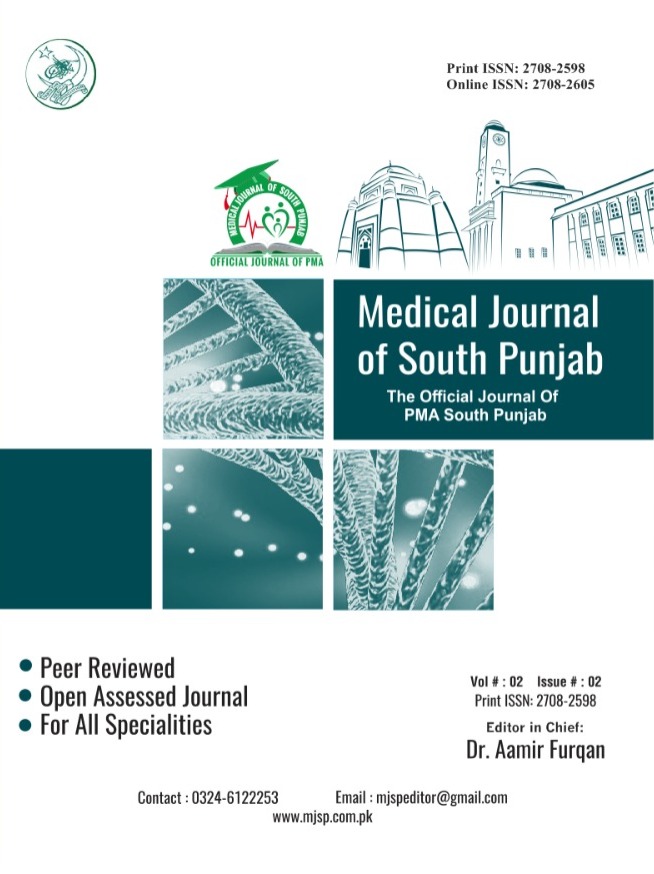Maternal Outcome in Patient having Morbid Adherence of Placenta after Hysterectomy
Placenta Previa
DOI:
https://doi.org/10.61581/MJSP.VOL02/01/04Keywords:
Morbidly adherent placenta, hysterectomy, maternal outcom, pregnancy, gynecologyAbstract
Objective: To determine maternal outcome in patient having morbid adherence of placenta after hysterectomy.
Methodology: Cross sectional study was conducted in the department of obstetrics and gynaecology Nishter hospital and Khawaja Fareed Social Security Hospital, Multan from August 2018 to August 2019. One hundred and eight patients with MAP on transabdominal ultrasonography (USG). All the patients had hysterectomies. All these patients were assessed for outcome parameters (urinary bladder injury, DIC and death). SPSS version 23 was used for data analysis. Student t test and chi square test were applied to see association among variables. P value ?0.05 was taken as significant.
Results: The complications were present in 27 (25%) patients. Urinary bladder injury, DIC and mortality was observed in 23 (21.3%), 2 (1.9%), and 2 (1.9%) patients. There were 81 (75%) patients who did not have any complication.
Conclusion: Maternal outcome after hysterectomies for treatment of badly adherent placenta was associated with significant rate of morbidity. To reduce maternal mortality rate diagnosis of morbidly adherent placenta in antenatal period is necessary and caesarean hysterectomy is the best treatment option.
Downloads
References
1. Kliman JH. Behind every healthy baby is a healthy placenta. Reproductive and Placenta Reseach Unit 1997;1.
2. Van den Broek N, Ntonya C, Kayira E, White S, Neilson JP. Preterm birth in rural Malawi: high incidence in ultrasound-dated population. Human Reproduction 2005;20:3235-3237.
3. Mazouni C, Gorincour G, Juhan V, Bretelle F. Placenta accreta: a review of current advances in prenatal diagnosis. Placenta 2007;28:599-603.
4. Abramowicz JS, Sheiner E. In utero imaging of the placenta: importance for diseases of pregnancy. Placenta 2007;28:14-22.
5. Vora K, Chandana P, Patel A, Jain M. A prospective study of 20 cases of maternal outcome in morbidly adherent placenta in tertiary care hospital. Intl J Reproduction, Contraception, Obstetrics Gynecology 2017;6(2):571.
6. Desai R, Jodha B, Garg R. Morbidly adherent placenta and it’s maternal and fetal outcome. International Journal of Reproduc-tion, Contraception, Obstetrics and Gynecology 2017;6(5):1890.
7. Hetty M, Dryden D. Morbidly adherent placenta: Ultrasound assessment and supplemental role of magnetic resonance imaging. Seminars in Ultrasound, CT and MRI 2015;36:324-31.
8. Pekar-Zlotin M, Melcer Y, Levinsohn-Tavor O, Tovbin J, Vaknin Z, Maymon R. Cesarean scar pregnancy and morbidly adherent placenta: Different or similar?. The Israel Medical Association journal: IMAJ 2017;19(3):168.
9. Rac M, Wells C, Twickler D, Moschos E, McIntire D, Dashe J. Placenta accreta and vaginal bleeding according to gestational age at delivery. Obstetrics & Gynecology 2015;125(4):808-13.
10. Eller AG, Bennett MA, Sharshiner M, Masheter C, Soisson AP, Dodson M, et al. Maternal morbidity in cases of placenta accrete managed by a multidisciplinary care team compared with standard obstetric care. Obstet Gynecol 2011;117:331-7.
11. Hasan AA, Hasan JA, Khan AA. Management and maternal outcome in morbidly adherent placenta. J Surg Pak 2009;14:166-9.
12. Sultana N, Mohyuddin S, Jabbar T. Management and maternal outcome in morbidly adherent placenta J Ayub Med Coll Abbottabad 2011;23:93-6.
13. Jalil S, Nausheen S, Akhter AZ. Reducing morbidity and mortality in morbidly adherent placenta: an experience. Pak J Surg 2011; 27:59-63.
14. Hoffman MS, Karlnoski RA, Mangar D. Morbidity associated with nonemergent hysterectomy for placenta accreta. Am J Obstet Gynecol 2010;202:628.e1-5.
15. Edwin WH Th ia, Lay –Kok Tan. Lessons learnt from two women with morbidly Adherent Placentas. Ann Acad Med Singapore 2007;36: 298-303.
16. O'Brien JM, Barton JR, Donaldson ES: The management Of Placenta previa conservative and operative strategies Am J Obstet. Gyne. 1996;175:1632-8.
17. Bailit JL, Grobman WA, Rice MM, et al. Morbidly adherent placenta treatments and outcomes. Obstet Gynecol. 2015;125(3):683–89.
18. Tahir N, Adil M, Afzal B. Definit treatment of morbidly adherent placenta: Analysis of maternal outcomes. Pak ArmedForcesMed J 2018;68(5):1156-60.
19. Chaudhari H, Shah P, D’Souza N. Morbidly adherent placenta: Its Management and maternal and perinatal outcome. JObste-tricsGynecologyIndia 2016;67(1):42-47.
Downloads
Published
Issue
Section
License
Copyright (c) 2021 Rahat Akhter, Asiya Rehman, Rabia Rehman, Rahat Akhtar, Tayyaba Rafiq, Wadiyat Khan

This work is licensed under a Creative Commons Attribution 4.0 International License.
Authors retain copyright and grant the journal right of first publication with the work simultaneously licensed under a Creative Commons Attribution (CC-BY) 4.0 License that allows others to share the work with an acknowledgment of the work’s authorship and initial publication in this journal.







